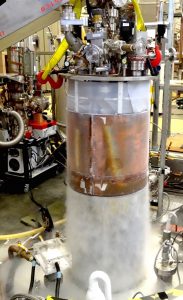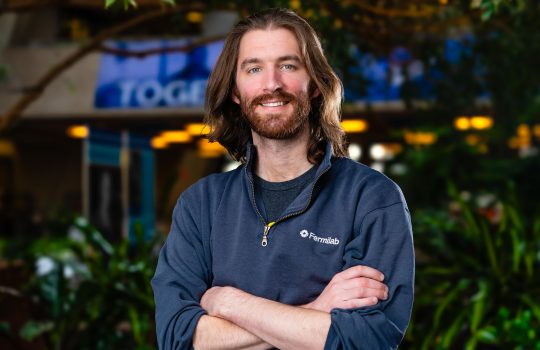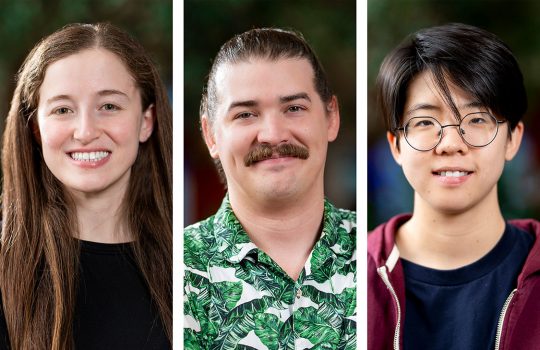
As the ADMX detector is removed from its magnet, the liquid helium used to cool the experiment forms vapor. Photo: Rakshya Khatiwada
ADMX, with its world-leading sensitivity, has ruled out axions of a certain mass range as dark matter.
Axions are a hypothetical candidate for the dark matter that makes up most of the mass of our Milky Way galaxy. The Axion Dark Matter eXperiment looks for “invisible” axions coming from our galaxy that convert into detectable particles of light, called photons, within the experiment’s powerful magnetic field.
“When you look for a new particle like an axion, you are exploring interactions that result in known particles, like photons,” said Rakshya Khatiwada, Fermilab research associate who has led the low-noise detector development for ADMX for the past four years.
Fermilab is the lead DOE laboratory for ADMX, which is hosted by the University of Washington. Fermilab is funded by the Department of Energy Office of Science.
Inside ADMX, a superconducting magnet generates a magnetic field that would turn undetectable axions into photons. Within that field sits a detector that can be tuned to different frequencies corresponding to signals of axions of different masses coming from the halo of dark matter in the Milky Way, similar to how a radio tunes into a radio station.
If you could stretch a ruler from one end of the visible Milky Way to the other, it would measure about 100,000 light-years across, meaning it would take light – the fastest thing in the universe – that many years to travel from one end to the other. For perspective, it takes light only eight minutes to travel from the sun to Earth.
But the actual size of our galaxy might be even larger than that.
Scientists believe a spherical cloud of dark matter – a dark matter halo – encloses nearly every galaxy. This galactic dark matter would be densest at the center of the galaxy, with decreasing density as one moves outward. The Earth is about 25,000 light-years from the center of the Milky Way, so physicists can predict what the local density of dark matter should be.
The existence of dark matter was first proposed in 1933 based on the motion of the Coma galaxy cluster. Scientist Fritz Zwicky calculated that, given the way galaxies near the cluster’s edge were moving, the cluster should have had far more mass than had been observed. To account for the apparent lack of sufficient mass, he proposed that some additional matter — dark matter — must be at work. The evidence for dark matter has since piled up, but scientists have yet to directly detect the building blocks of this invisible matter in the laboratory.
The challenge with finding dark matter is that it very rarely interacts with ordinary matter. For comparison, take the neutrino — a known particle that was once thought to be a candidate for the dark matter. Neutrinos are famous for their very weak interactions – about 100 billion pass through the tip of your thumb every second. They sail through you without you, or your body, ever noticing. And yet, scientists figured out how to build experiments to detect neutrinos. The fact that we still haven’t detected dark matter means that their interactions are even weaker and that we need even more sensitive experiments to detect them.
If found, axions would also solve another physics conundrum: the strong charge-parity problem.
In 1977, physicists Helen Quinn and Roberto Peccei proposed a new model to explain why the strong interactions do not violate charge-parity (CP) symmetry. Shortly thereafter, two other physicists (and later Nobel Prize winners) Frank Wilczek and Steven Weinberg realized that Peccei and Quinn’s model predicted the existence of a new particle, the axion, and it was later realized that axions could be the dark matter. The strong CP problem is complex, but it essentially has the same problem that astrophysics has without dark matter: Theory and observation, relating to the Standard Model of physics, don’t match up. As with dark matter, this enigma means that there is something that scientists have yet to fully understand about nature.
The potential to answer two big physics questions at once makes axions popular particles to search for.
In 2017, ADMX operated with the highest sensitivity of any axion experiment to date. In doing so, it ruled out a range of possible axion masses.
Now the ADMX collaboration released its latest results based on data taken in 2018. The new results rule out yet another mass range, four times wider than the first, while maintaining the same degree of exceptional sensitivity.
“This result is as good as it gets for axions in the mass range ADMX is sensitive to,” Khatiwada said. “Which is incredibly valuable, because we’re saying, with a higher degree of certainty than ever before that axions do not exist there.”
Scientific discoveries, especially of particles that very rarely interact with matter, rely on this weeding out process. The Higgs boson, for example, was discovered by the LHC in 2012, nearly 50 years after it was first proposed. Without both CERN’s Large Electron-Positron Collider and Fermilab’s Tevatron constraints on what masses were possible for the elusive particle, the LHC experiments wouldn’t have known exactly where to look. Without setting constraints, it is virtually impossible to home in on new, weakly interacting particles.
With both results, ADMX has ruled out the possibility of axions existing with mass between 2.66 and 3.33 millionths of an electronvolt in energy. For comparison, the mass of the electron is 511,000 electronvolts.
With more data and its superb sensitivity, ADMX will be able to discover whether axions exist or rule them out over a much broader range of masses.
ADMX will start another data-taking run this year to explore the range above 3.33 millionths of an electronvolt. And it will only increase its sensitivity to axions with new and upcoming advances in reducing background noise.
“It’s surreal to help build and operate an experiment that is one of a kind in the world,” said Khatiwada. “It’s really rewarding to see everyone from graduate students and postdocs to scientists and professors’ hard work pay off.”
To learn more about ADMX’s search for dark matter, watch this 3-minute YouTube video.
To learn more about Rakshya Khatiwada’s work at Fermilab, read this interview with her.



